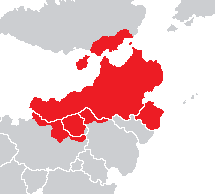User:Britbong64/Sandbox 4: Difference between revisions
Jump to navigation
Jump to search
Britbong64 (talk | contribs) No edit summary |
Britbong64 (talk | contribs) No edit summary |
||
| Line 33: | Line 33: | ||
|flag_type_article = | |flag_type_article = | ||
|flag_type = Imperial Banner | |flag_type = Imperial Banner | ||
|image_coat = | |image_coat = Confed CoA.png | ||
|coa_size = | |coa_size = | ||
|symbol = | |symbol = | ||
Revision as of 10:37, 8 August 2021
Rudolphine Confederation Eidgenossenschaft | |
|---|---|
| 1027-1786 | |
 The Rudolphine Confederation at its greatest extent prior to the Amendist Wars in 1582. | |
| Capital | No single/fixed capital |
| Common languages | Medieval Solarian (administrative/liturgical/ceremonial), Weranian, Aldman, Azmaran, Borish, Dellish, Kirenian, Ruttish, Solstianan, Swathish |
| Religion | Catholicism, Amendism |
| Government | Confederal elective monarchy |
| Rudolphine Emperor | |
• 1027-1051 (first) | Rudolf I |
• 1764-1785 (last) | Leopold III |
| Legislature | Tagsatzung |
| Historical era | Middle Ages Early modern period |
• Established | 1027 |
• Disestablished | 1786 |
History
- Founded in 1027 after King Rudolf led the Eidgenossenschaft (oath-fellowship) against the Verliquoians/Estmerish preventing their expansion into northern Euclea, in particular Borland. Rudolf was crowned as the Leader of the Eidgenossenschaft, commonly known as Emperor of the Rudolphine Confederation by Verliquoians.
- Initially the Confederation was mostly pagan being partly founded on entrenching pagan exceptionalism in northern Euclea. However there existed Sotirian communities with the imperial authority not *per se* repudiating Sotirianity.
- In 1106 Emperor Rudolf III converted to Sotirianity and begun a campaign of eradicating paganism in the confederation.
- Following Rudolf III's conversion the confederation gain papal permission to go on crusades - Ruttland, Alsland(?), Kirenia(?), Bonnlitz, Scovern(?), Caldia over the next half century
- Rivalry with the Third North Sea Empire in Caldia-Scovern and Maritime Guild in Kirenia.
- Reaches maximum extent prior to the Amendist wars.
- Amendist Wars leads to civil war in the Confederation and many of its members to leave the authority of the Emperor.
- Decline during the 17th century. This was accompanied by a centralisation of power by the imperial house starting under Otto IX (1646-1695) abolishing many of the rights of the monarchies concentrating power in the hands of the imperial house.
- Ten Years' War leads to the further destruction of the Confederation.
- Following the Ten Years' War the confederation continues centralising; this causes further discontent.
- 1785 - revolution creates a constitutional regime, which then becomes a republic a year later.
Politics
- Kinda a mix between the Old Swiss Confederation and Holy Roman Empire.
- Originally founded - basically when the Emperor requests troops to fight in a war, the constituent states send a levy. Most wars within the confederation are crusades against pagans(?) or against external threats. The central state also demands some taxes, but aside from that member states are basically autonomous.
- Following the Amendist Wars the Federal Diet (Tagsatzung) is founded, which consists of representatives sent from the states. This leads to increased conflict between the emperor and the Tagsatzung.
- In 1652 Emperor Otto IX revokes many noble privileges including the marginalisation of the Tagsatzung heralding the start of absolutism in the confederation.
- Following the Ten Years' War far more centralisation is pursued - more taxes, more authority to the church, less respect for ancient privileges. Tagsatzung increasingly marginalised in favour of absolutism.

